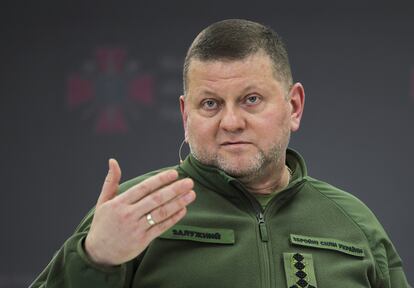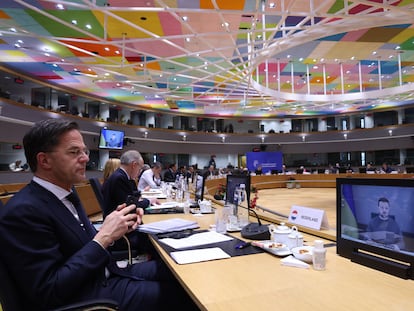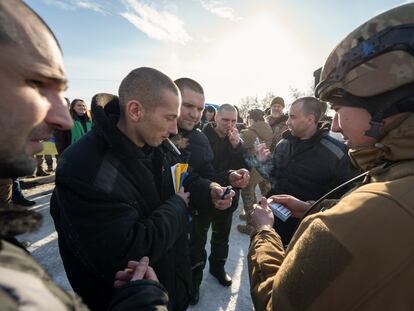Ukraine’s president appoints new army leader at pivotal moment in war with Russia
Zelenskiy appointed Сol. Gen. Oleksandr Syrskyi, the commander of Ukraine’s ground forces, to lead the army. Syrskyi, 58, has since 2013 been involved in the Ukrainian army’s effort to adopt NATO standards

Ukrainian President Volodymyr Zelenskiy replaced his top army general on Thursday in what amounts to a major shake-up of the country’s war strategy as the conflict with Russia grinds into its third year and Ukraine grapples with shortages of ammunition and personnel.
In a post on X, Zelenskiy said he thanked Gen. Valerii Zaluzhnyi — a military leader popular with troops and the general public — for his two years of service as commander-in-chief. “The time for such a renewal is now,” Zelenskiy said.
Zelenskiy appointed Сol. Gen. Oleksandr Syrskyi, the commander of Ukraine’s ground forces, to lead the army. Syrskyi, 58, has since 2013 been involved in the Ukrainian army’s effort to adopt NATO standards.
Zaluzhnyi, in a Telegram message, did not announce he had stepped down but said he accepted that “everyone must change and adapt to new realities” and agreed that there is a “need to change approaches and strategy” in the war.
The statement followed days of speculation spurred by local media reports that Zelenskiy would sack Zaluzhnyi in the most far-reaching shake-up of the top military brass since Russia’s full-scale invasion of Ukraine on Feb. 24 2022.
Ukraine’s struggles with ammunition and personnel come on the heels of a failed summer counteroffensive last year.
Zaluzhnyi was highly regarded by his troops and by foreign military officials. Some analysts warned that his exit could bring unwelcome disruption, potentially driving a wedge between the Ukrainian army and politicians, and fueling uncertainty among Kyiv’s Western allies.
There has been little change in positions along the 1,500-kilometer (900-mile) front line over the winter, though the Kremlin’s forces have kept up their attacks at certain points. Faced with a shortfall in anticipated supplies of Western weaponry, Ukraine has been digging defenses, while Moscow has put its economy on a war footing to give its military more muscle.
Rifts within Ukraine’s top leadership burst into the open recently with swirling rumors starting on Jan. 29 that Zaluzhnyi would be dismissed. Zelenskiy’s office and the Defense Ministry denied the rumors, but the reports fueled expectations he was on his way out.
Strains had appeared between Zaluzhnyi and Zelenskiy — arguably the two most prominent figures in Ukraine’s fight — after the much-anticipated counteroffensive failed to meet its goal of penetrating Russia’s deep defenses. Kyiv’s Western allies had poured billions of dollars’ worth of military hardware into Ukraine to help it succeed.
Months later, amid signs of war fatigue in the West, Zaluzhnyi described the conflict as being at a “stalemate,” just when Zelenskiy was arguing in foreign capitals that Ukraine’s new weaponry had been vital.
Zelenskiy said at the end of last year that he had turned down the military’s request to mobilize up to 500,000 people, demanding more details about how it would be paid for.
Born into a family of Soviet servicemen, Zaluzhnyi is credited with modernizing the Ukrainian army along NATO lines. He took charge seven months before Russia’s full-scale invasion.
Widely regarded in the West as an ambitious and astute battlefield commander, he has had a reputation for modesty in Ukraine.
Zaluzhnyi earned broad public support after the successful defense of Kyiv in the early days of the war, followed by a triumphant counteroffensive in the Kharkiv region and the liberation of Kherson. His courage and defiance of Russia’s ambitions were renowned, and he became a symbol of resilience and national unity.
“We are on our land and we will not give it up,” Zaluzhnyi said on the first day of the war.
Despite his popularity, Zaluzhnyi shied from the spotlight, deferring that role to Zelenskiy. He made limited public appearances and rarely gave interviews.
Retired Australian Maj. Gen. Mick Ryan, a fellow of the Center for Strategic and International Studies think tank in Washington, described Zaluzhnyi as “a charismatic and popular military leader” who would be hard to replace.
His replacement will have to build personal relationships with U.S. and NATO military chiefs while the perception of government instability “is a real danger area for” Zelenskiy, Ryan wrote recently in an article posted online.
Meanwhile, Ukrainian forces claimed to have shot down a Russian attack helicopter in eastern Ukraine near the city of Avdiivka, where soldiers are fighting from street to street as Russia’s army steps up its four-month campaign to surround Kyiv’s defending troops.
Ukrainian soldiers used a portable anti-aircraft missile to take down the Ka-52 Alligator attack helicopter, one of the Russian air force’s deadliest weapons, according to Oleksandr Tarnavskyi, the commander of Ukrainian units fighting on the southeastern front line.
Avdiivka has become “a primary focus” of Moscow’s forces, the U.K. Defense Ministry said in an assessment Thursday.
Street-to-street combat is taking place in the city as Ukrainian troops seek to keep open their main supply route amid intense bombardment, the ministry said on X, formerly known as Twitter.
The General Staff of Ukraine’s armed forces reported Thursday that its troops had fended off 40 enemy assaults around Avdiivka over the previous 24 hours. That is roughly double the number of daily Russian assaults at other points along the front line.
Russia’s Pravda newspaper reported Thursday that the Russian army was attempting to cut a key logistics supply route for Ukraine in the village of Lastochkyne, about 6 kilometers (4 miles) west of Avdiivka.
The Russian military has used electronic warfare to take out the Starlink communications system which Ukrainian troops use to communicate, Pravda said.
Ukraine has built multiple defenses in Avdiivka, complete with concrete fortifications and a network of tunnels. Despite massive losses of personnel and equipment, Russian troops have slowly advanced since October.
The fight has evolved into a gruesome effort for both sides. It has been compared to the nine months of fighting for Bakhmut, the Ukraine war’s longest and bloodiest battle. It ended with Russia capturing the bombed-out, deserted city last May in what Moscow hailed as a major triumph.
Both Bakhmut and Avdiivka are located in Ukraine’s Donetsk region. Moscow-backed rebels seized part of the region in 2014 and Russia illegally annexed all of it in 2022 with three other Ukrainian regions.
Russia wants to capture the entire Donetsk region, where it currently holds just over half of the territory.
Sign up for our weekly newsletter to get more English-language news coverage from EL PAÍS USA Edition
Tu suscripción se está usando en otro dispositivo
¿Quieres añadir otro usuario a tu suscripción?
Si continúas leyendo en este dispositivo, no se podrá leer en el otro.
FlechaTu suscripción se está usando en otro dispositivo y solo puedes acceder a EL PAÍS desde un dispositivo a la vez.
Si quieres compartir tu cuenta, cambia tu suscripción a la modalidad Premium, así podrás añadir otro usuario. Cada uno accederá con su propia cuenta de email, lo que os permitirá personalizar vuestra experiencia en EL PAÍS.
¿Tienes una suscripción de empresa? Accede aquí para contratar más cuentas.
En el caso de no saber quién está usando tu cuenta, te recomendamos cambiar tu contraseña aquí.
Si decides continuar compartiendo tu cuenta, este mensaje se mostrará en tu dispositivo y en el de la otra persona que está usando tu cuenta de forma indefinida, afectando a tu experiencia de lectura. Puedes consultar aquí los términos y condiciones de la suscripción digital.
More information
Archived In
Últimas noticias
Welcome to the post-religion era: The idea of Christianity as the absolute truth has become obsolete
‘I thought you would like it’: The risky sexual practice popularized by TV shows and TikTok
The digitalization of tourism: ‘They promise experiences and gave us the worst possible one’
Mexican peso defies uncertainty with forecasts of a new period of stability in 2026
Most viewed
- Sinaloa Cartel war is taking its toll on Los Chapitos
- Reinhard Genzel, Nobel laureate in physics: ‘One-minute videos will never give you the truth’
- Oona Chaplin: ‘I told James Cameron that I was living in a treehouse and starting a permaculture project with a friend’
- Why the price of coffee has skyrocketed: from Brazilian plantations to specialty coffee houses
- Silver prices are going crazy: This is what’s fueling the rally










































